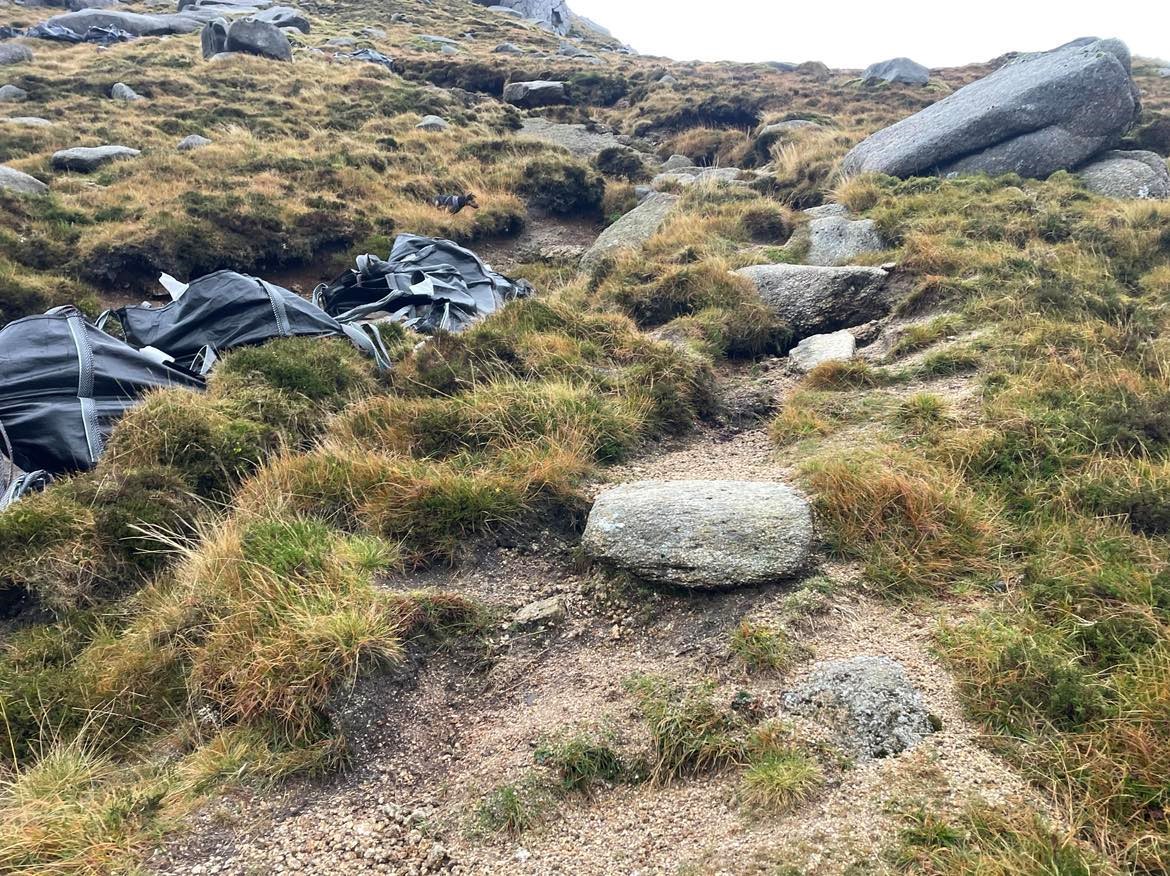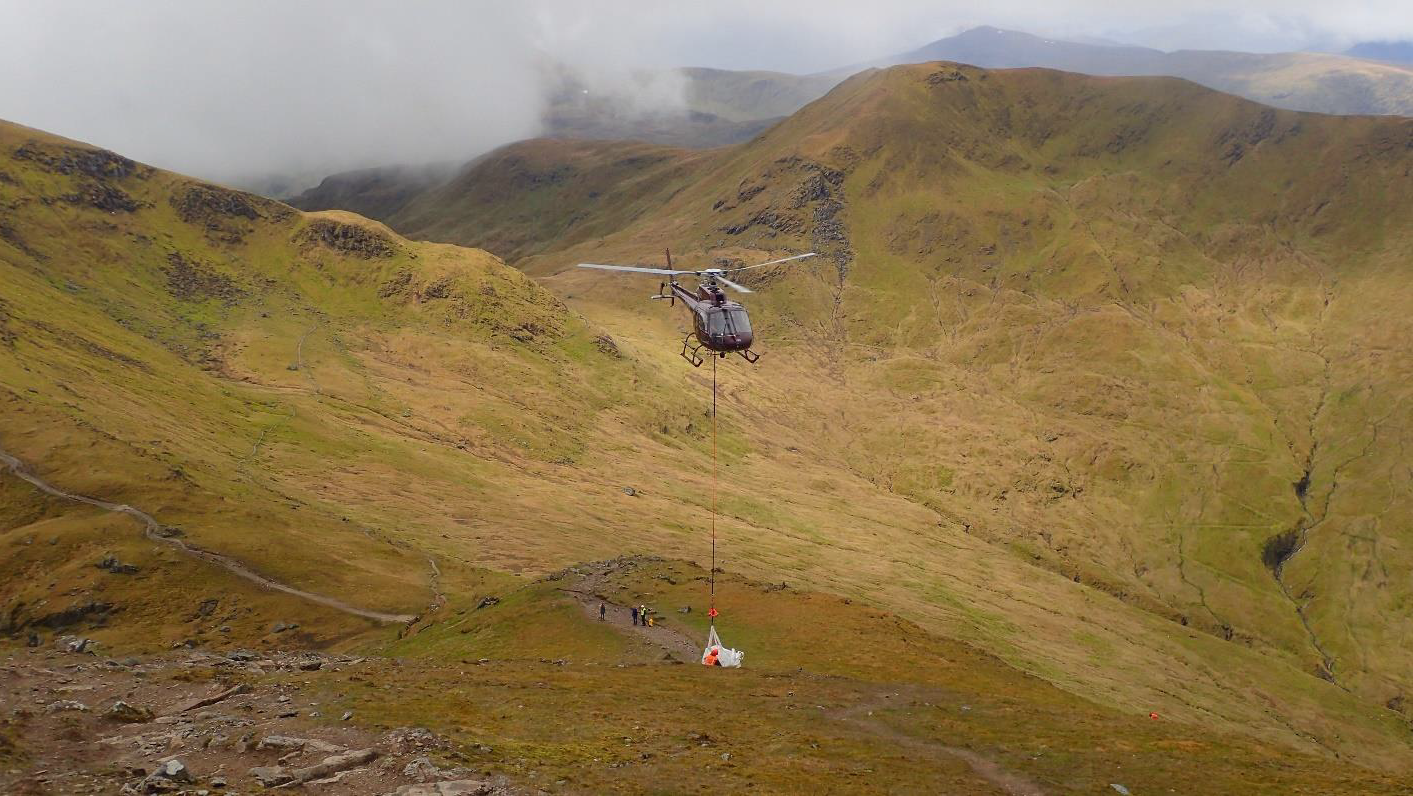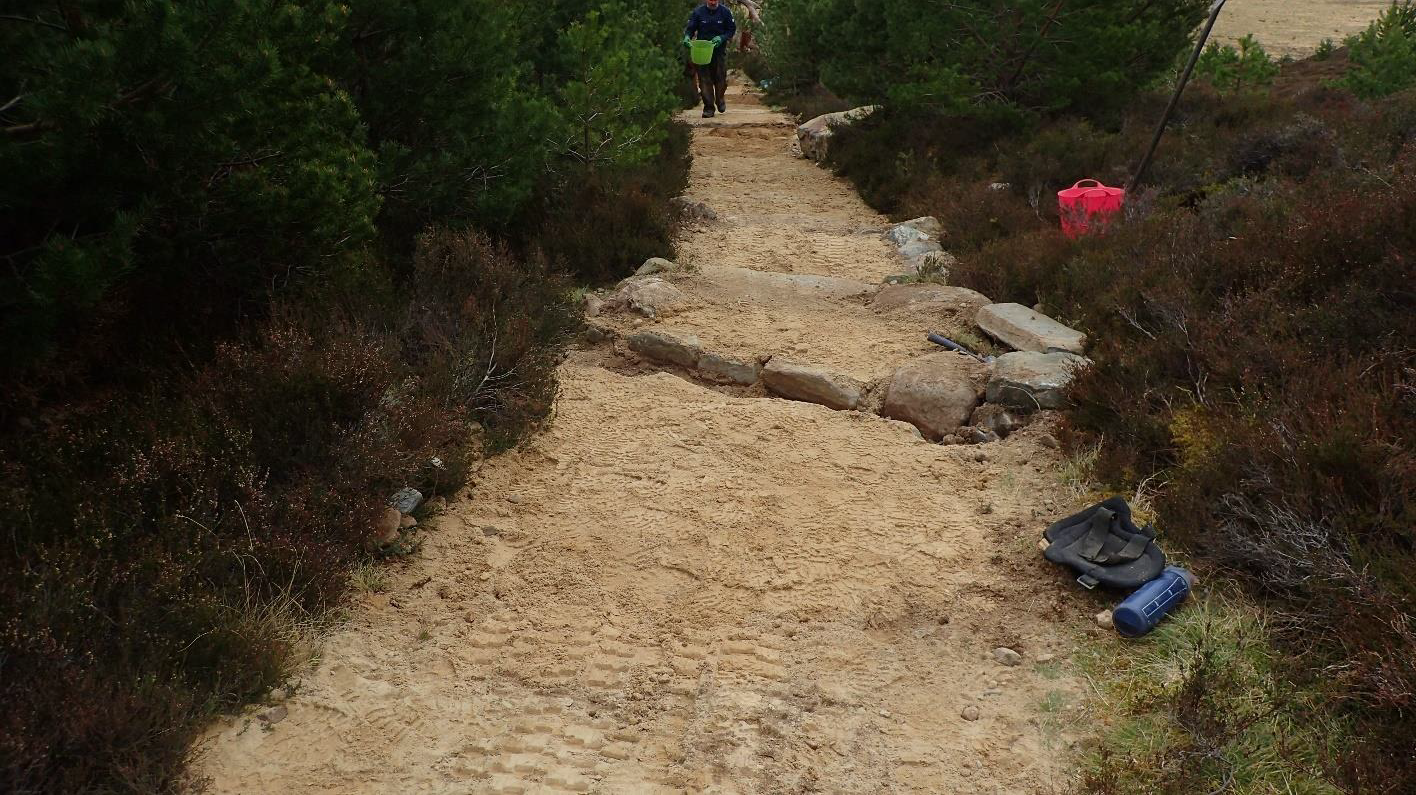A gulley has evolved on Cìr Mhòr, a Corbett on the Isle of Arran, which could potentially jeopardise previous efforts of the Footpath Team and damage the area’s natural habitat. The gulley fills with rainwater and melted snow which then cascades down the rockface, causing erosion and posing a significant threat to the existing footpath lower down the mountain. We need your help to safeguard the remarkable work of the Footpath Team and preserve the beauty of this iconic place!
Image: The path (red line) on Cìr Mhòr.
The efforts of the Footpath Team on the lower section of path ten years ago yielded remarkable results, successfully restoring the path and its surrounding environment. Our intervention was so effective that we are now determined to address the upper section of the path as well.
Image: Earlier restoration work completed on Cìr Mhòr. The Footpath Team skillfully blend the path into the natural face of the mountain.
Standing at the head of Glen Rosa and Glen Sannox, in the northern reaches of the picturesque Isle of Arran, Cìr Mhòr stands proudly as the majestic sentinel. Often hailed as “the crown jewel of the range”, its name, “big comb”, aptly captures the mountain’s striking resemblance to a rooster’s comb, with its iconic, peak-shaped profile. Boasting steep faces and rugged, boulder-strewn paths, Cìr Mhòr is a popular challenge for adventurous climbers and offers a panoramic vantage point for gazing across the island’s pristine landscape.
This specific section of path on Cìr Mhòr carves through an incredibly steep and mobile piece of the mountain, with few ways to climb it without a rope. The difficult terrain causes people to stray from the path into the surrounding areas, which can inadvertently leave ugly scars on the landscape and put fragile ecosystems at risk. By intervening now, we can direct adventurous climbers along a single line, limiting potential damage, and redirect the waterflow from the gulley to protect existing work at the same time.
Image: Within the gulley on Cìr Mhòr. Erosion and damage to the path can be seen in the foreground.
The formidable terrain of this Corbett presents a unique challenge to more than just avid mountaineers. The Isle of Arran is an exceptional location, but it suffers some of the biggest problems from both the East and West of Scotland in terms of climate and geology. The northern mountains, characterised by their granitic composition, are particularly vulnerable to wind erosion, a prevailing issue along the East coast. Simultaneously, Arran experiences substantial rainfall like much of western Scotland, which can cause the ground to erode very quickly. When these downpours meet solid granite, it creates rapid channels that carve their way down the mountainside, causing erosion and risking the diligent efforts of the Footpath Team.
Image: Helicopter dropping stone at Ben Lawers, using stone to repair and control erosion below -- like we plan to do on Cìr Mhòr.
Much of the required work involves repositioning material that is already there. Large natural stones can enhance the existing path, making it more appealing than the current scramble. However, additional stone is still necessary, as there’s insufficient material to redistribute without risking exposing the ground to further erosion and removing valuable shelter for flora and fauna. The team will therefore need to fly materials in via airlift, importing stone from a nearby scree slope. Each helicopter bag – all filled by hand! -- contains 500kg to 1,000kg of stone. 7,500kg of stone needs to be flown in, and the helicopter will need to successfully land on a section of the mountain not much bigger than your average back garden!
Image: Improved drainage on a path at Glen Quoich, Mar Lodge Estate.
The team’s main objective is stabilisation of the land, combating wear from footfall and harsh weather conditions. Clever stone pitching – interlocking large stones with their flattest side up to create small irregular steps – will help the path blend into the natural landscape, and line definition will help maintain one sustainable line. Drainage work will also be expertly incorporated into the path to subtly draw off excess water from the gulley. By backfilling their work with spoil from the site, the team are hopeful they can encourage natural regeneration of indigenous vegetation.
Image: Stone pitching used to repair another damaged section of the path on Cìr Mhòr.
We need your support to achieve this. A total of £5,000 is required to cover the costs of materials and staff time dedicated to restoring this vital section of the path. Our Footpath Team relies solely on donations to continue their incredible work. With your help, we can secure the funds needed to protect one of Scotland’s most awe-inspiring mountains. Your contribution, no matter the size, will make a significant impact. Join us in preserving the natural beauty of Cìr Mhòr by donating today!
• £5 will pay for 1 helicopter bag
• £30 will cover the cost of labour to fill 1 helicopter bag
• £50 could help us care for 1.2m of footpath, clear out vital ditching or restore a section of trampled ground
• £75 can help us airlift repair materials
• £100 will cover the cost of bagging all necessary materials
Image: Helibags - weighing up to 1,000kg! - ready to be lifted on Cìr Mhòr.
One of our Founders’ Circle donors has generously pledged to match any donations made. For every £1 given, he will match it, up to £2,500. The donor has supported the Footpath Fund work for several years and has family connections to Arran. Can you help us raise the other £2,500?
The National Trust for Scotland cares for, shares and speaks up for Scotland’s natural, built and cultural heritage. Since 1931, fuelled by our love of Scotland, we’ve undertaken hundreds of conservation projects, protected thousands of acres of wild habitat and safeguarded countless items in our collections spanning every Scottish region. We heavily depend on public donations to accomplish our mission of protecting Scotland’s unique treasures, from coastlines to castles, wildlife to wilderness, and art to architecture. We encourage people to come together and connect through the things that make Scotland unique, and to protect them for future generations.
Image: Members of the Footpath Team.
Caring for 245 miles (over 400km) of upland footpaths across Scotland, our Footpath Team faces the challenge of maintaining our paths against harsh weather conditions and increasing foot traffic. Their vital work prevents erosion, preserving delicate ecosystems and native flora and fauna. Led by Bob Brown, Upland Paths Manager, the team tirelessly manages and minimises destruction, reversing decades of damage – natural and man-made – in Scotland’s mountain landscapes.
The team have limited resources, which they use to assess and address essential restoration work and improve access to the paths that are enjoyed by so many. Their work is 100% reliant on donations received to our charity. Every step you take has been carefully considered and is a thoughtful stride towards conservation.
It is only with the support of our donors that the Footpath Team can carry out their crucial work. Thanks to you, the Footpath Team can ensure our upland footpaths are protected for us to enjoy today, and for everyone who follows in our footsteps.
If we successfully reach our target, any additional monies raised will go towards additional repairs and landscaping in the surrounding area on Arran.
 Organised by National Trust for Scotland
Organised by National Trust for Scotland






